
Illustrative Math Alignment: Grade 7 Unit 7
Expressions, Equations, and Inequalities
Lesson 9: Dealing with Negative Numbers
Use the following Media4Math resources with this Illustrative Math lesson.
| Thumbnail Image | Title | Body | Curriculum Topic |
|---|---|---|---|
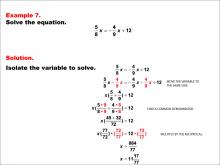
|
Math Example--Solving Equations--Equations with Fractions: Example 7 | Equations with Fractions: Example 7TopicEquations DescriptionThis example illustrates solving Equations with Fractions: Example 7 which involves fractions. These equations can be addressed by first removing the fractions by finding a common denominator and multiplying through. This transforms the equation into a standard linear form that can then be solved by isolating the variable. The specific equation in the image shows the importance of maintaining accuracy in operations, and understanding the process is crucial for advancing in algebra. |
Solving Fraction Equations |
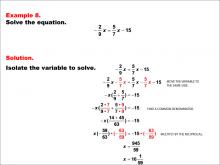
|
Math Example--Solving Equations--Equations with Fractions: Example 8 | Equations with Fractions: Example 8TopicEquations DescriptionThis example illustrates solving Equations with Fractions: Example 8 which involves fractions. These equations can be addressed by first removing the fractions by finding a common denominator and multiplying through. This transforms the equation into a standard linear form that can then be solved by isolating the variable. The specific equation in the image shows the importance of maintaining accuracy in operations, and understanding the process is crucial for advancing in algebra. |
Solving Fraction Equations |
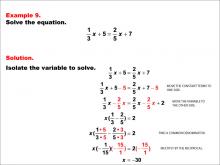
|
Math Example--Solving Equations--Equations with Fractions: Example 9 | Equations with Fractions: Example 9TopicEquations DescriptionThis example illustrates solving Equations with Fractions: Example 9 which involves fractions. These equations can be addressed by first removing the fractions by finding a common denominator and multiplying through. This transforms the equation into a standard linear form that can then be solved by isolating the variable. The specific equation in the image shows the importance of maintaining accuracy in operations, and understanding the process is crucial for advancing in algebra. |
Solving Fraction Equations |
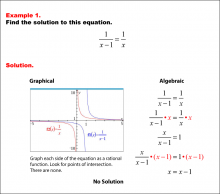
|
Math Example--Solving Equations--Extraneous Or No Solutions--Example 1 | Extraneous Or No Solutions--Example 1TopicEquations |
Radical Functions and Equations and Rational Functions and Equations |
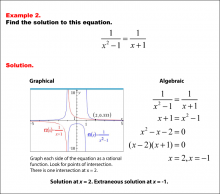
|
Math Example--Solving Equations--Extraneous Or No Solutions--Example 2 | Extraneous Or No Solutions--Example 2TopicEquations |
Radical Functions and Equations and Rational Functions and Equations |
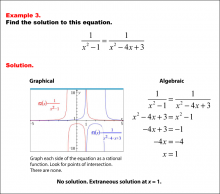
|
Math Example--Solving Equations--Extraneous Or No Solutions--Example 3 | Extraneous Or No Solutions--Example 3TopicEquations |
Radical Functions and Equations and Rational Functions and Equations |
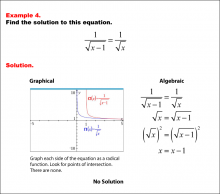
|
Math Example--Solving Equations--Extraneous Or No Solutions--Example 4 | Extraneous Or No Solutions--Example 4TopicEquations |
Radical Functions and Equations and Rational Functions and Equations |
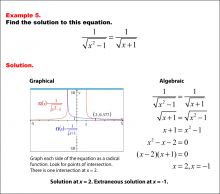
|
Math Example--Solving Equations--Extraneous Or No Solutions--Example 5 | Extraneous Or No Solutions--Example 5TopicEquations |
Radical Functions and Equations and Rational Functions and Equations |
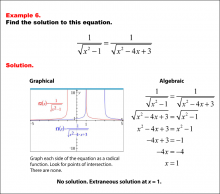
|
Math Example--Solving Equations--Extraneous Or No Solutions--Example 6 | Extraneous Or No Solutions--Example 6TopicEquations |
Radical Functions and Equations and Rational Functions and Equations |
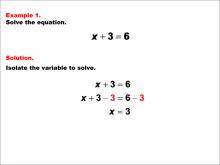
|
Math Example--Solving Equations--One-Variable Equations: Example 1 | One-Variable Equations: Example 1TopicEquations |
Solving Multistep Equations, Solving One-Step Equations and Solving Two-Step Equations |
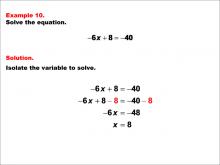
|
Math Example--Solving Equations--One-Variable Equations: Example 10 | One-Variable Equations: Example 10TopicEquations DescriptionThis example involves solving a one-variable equation that may include complex terms or require multiple steps to simplify. The equation might involve fractions, decimals, or variables on both sides. Solving it involves using inverse operations, distributing terms, and combining like terms to isolate the variable. This type of problem helps students refine their algebraic skills and understand the importance of systematic problem-solving. Checking the solution by substituting it back into the original equation is a crucial step to ensure accuracy. |
Solving Multistep Equations, Solving One-Step Equations and Solving Two-Step Equations |
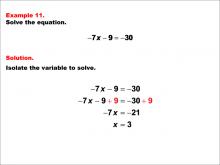
|
Math Example--Solving Equations--One-Variable Equations: Example 11 | One-Variable Equations: Example 11TopicEquations |
Solving Multistep Equations, Solving One-Step Equations and Solving Two-Step Equations |
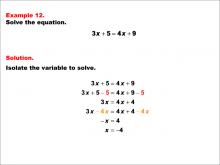
|
Math Example--Solving Equations--One-Variable Equations: Example 12 | One-Variable Equations: Example 12TopicEquations DescriptionThis example presents a one-variable equation that may involve variables on both sides. The solving process requires moving all terms involving the variable to one side and constants to the other. This often involves using the distributive property and combining like terms. The goal is to isolate the variable and solve for its value. This type of problem helps students develop their algebraic manipulation skills and understand the importance of maintaining balance in an equation. Checking the solution by substituting it back into the original equation is crucial to ensure accuracy. |
Solving Multistep Equations, Solving One-Step Equations and Solving Two-Step Equations |
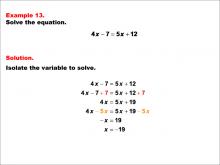
|
Math Example--Solving Equations--One-Variable Equations: Example 13 | One-Variable Equations: Example 13TopicEquations DescriptionThis example involves solving a one-variable equation that might include complex expressions, such as those with parentheses or multiple terms. The solving process may require using the distributive property to eliminate parentheses and combining like terms to simplify the equation. After simplification, standard techniques are used to isolate the variable. This example reinforces the importance of following the order of operations and checking the solution for accuracy. Mastery of these skills is essential for tackling more advanced algebraic problems. |
Solving Multistep Equations, Solving One-Step Equations and Solving Two-Step Equations |
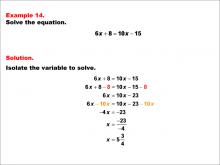
|
Math Example--Solving Equations--One-Variable Equations: Example 14 | One-Variable Equations: Example 14TopicEquations DescriptionThis example deals with solving a one-variable equation that may involve more complex algebraic expressions, such as nested parentheses or fractional coefficients. The solving process requires careful application of the distributive property and combining like terms. After simplifying the equation, inverse operations are used to isolate the variable. This example highlights the importance of precision in algebraic manipulation and the necessity of verifying solutions by substituting them back into the original equation to ensure correctness. |
Solving Multistep Equations, Solving One-Step Equations and Solving Two-Step Equations |
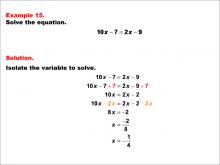
|
Math Example--Solving Equations--One-Variable Equations: Example 15 | One-Variable Equations: Example 15TopicEquations DescriptionThis example involves solving a one-variable equation that may include complex terms or require multiple steps to simplify. The equation might involve fractions, decimals, or variables on both sides. Solving it involves using inverse operations, distributing terms, and combining like terms to isolate the variable. This type of problem helps students refine their algebraic skills and understand the importance of systematic problem-solving. Checking the solution by substituting it back into the original equation is a crucial step to ensure accuracy. |
Solving Multistep Equations, Solving One-Step Equations and Solving Two-Step Equations |
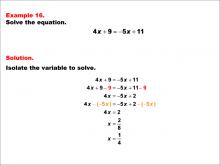
|
Math Example--Solving Equations--One-Variable Equations: Example 16 | One-Variable Equations: Example 16TopicEquations |
Solving Multistep Equations, Solving One-Step Equations and Solving Two-Step Equations |
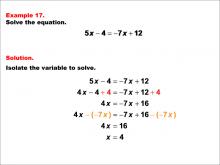
|
Math Example--Solving Equations--One-Variable Equations: Example 17 | One-Variable Equations: Example 17TopicEquations DescriptionThis example presents a one-variable equation that may involve variables on both sides. The solving process requires moving all terms involving the variable to one side and constants to the other. This often involves using the distributive property and combining like terms. The goal is to isolate the variable and solve for its value. This type of problem helps students develop their algebraic manipulation skills and understand the importance of maintaining balance in an equation. Checking the solution by substituting it back into the original equation is crucial to ensure accuracy. |
Solving Multistep Equations, Solving One-Step Equations and Solving Two-Step Equations |

|
Math Example--Solving Equations--One-Variable Equations: Example 18 | One-Variable Equations: Example 18TopicEquations DescriptionThis example involves solving a one-variable equation that might include complex expressions, such as those with parentheses or multiple terms. The solving process may require using the distributive property to eliminate parentheses and combining like terms to simplify the equation. After simplification, standard techniques are used to isolate the variable. This example reinforces the importance of following the order of operations and checking the solution for accuracy. Mastery of these skills is essential for tackling more advanced algebraic problems. |
Solving Multistep Equations, Solving One-Step Equations and Solving Two-Step Equations |
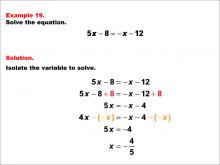
|
Math Example--Solving Equations--One-Variable Equations: Example 19 | One-Variable Equations: Example 19TopicEquations DescriptionThis example deals with solving a one-variable equation that may involve more complex algebraic expressions, such as nested parentheses or fractional coefficients. The solving process requires careful application of the distributive property and combining like terms. After simplifying the equation, inverse operations are used to isolate the variable. This example highlights the importance of precision in algebraic manipulation and the necessity of verifying solutions by substituting them back into the original equation to ensure correctness. |
Solving Multistep Equations, Solving One-Step Equations and Solving Two-Step Equations |
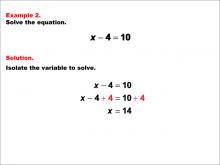
|
Math Example--Solving Equations--One-Variable Equations: Example 2 | One-Variable Equations: Example 2TopicEquations |
Solving Multistep Equations, Solving One-Step Equations and Solving Two-Step Equations |
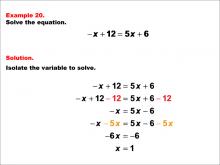
|
Math Example--Solving Equations--One-Variable Equations: Example 20 | One-Variable Equations: Example 20TopicEquations DescriptionThis example involves solving a one-variable equation that may include complex terms or require multiple steps to simplify. The equation might involve fractions, decimals, or variables on both sides. Solving it involves using inverse operations, distributing terms, and combining like terms to isolate the variable. This type of problem helps students refine their algebraic skills and understand the importance of systematic problem-solving. Checking the solution by substituting it back into the original equation is a crucial step to ensure accuracy. |
Solving Multistep Equations, Solving One-Step Equations and Solving Two-Step Equations |
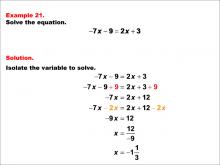
|
Math Example--Solving Equations--One-Variable Equations: Example 21 | One-Variable Equations: Example 21TopicEquations |
Solving Multistep Equations, Solving One-Step Equations and Solving Two-Step Equations |
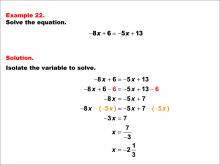
|
Math Example--Solving Equations--One-Variable Equations: Example 22 | One-Variable Equations: Example 22TopicEquations DescriptionThis example presents a one-variable equation that may involve variables on both sides. The solving process requires moving all terms involving the variable to one side and constants to the other. This often involves using the distributive property and combining like terms. The goal is to isolate the variable and solve for its value. This type of problem helps students develop their algebraic manipulation skills and understand the importance of maintaining balance in an equation. Checking the solution by substituting it back into the original equation is crucial to ensure accuracy. |
Solving Multistep Equations, Solving One-Step Equations and Solving Two-Step Equations |
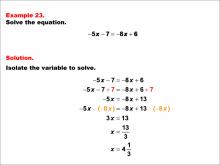
|
Math Example--Solving Equations--One-Variable Equations: Example 23 | One-Variable Equations: Example 23TopicEquations DescriptionThis example involves solving a one-variable equation that might include complex expressions, such as those with parentheses or multiple terms. The solving process may require using the distributive property to eliminate parentheses and combining like terms to simplify the equation. After simplification, standard techniques are used to isolate the variable. This example reinforces the importance of following the order of operations and checking the solution for accuracy. Mastery of these skills is essential for tackling more advanced algebraic problems. |
Solving Multistep Equations, Solving One-Step Equations and Solving Two-Step Equations |
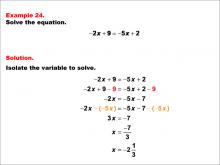
|
Math Example--Solving Equations--One-Variable Equations: Example 24 | One-Variable Equations: Example 24TopicEquations DescriptionThis example deals with solving a one-variable equation that may involve more complex algebraic expressions, such as nested parentheses or fractional coefficients. The solving process requires careful application of the distributive property and combining like terms. After simplifying the equation, inverse operations are used to isolate the variable. This example highlights the importance of precision in algebraic manipulation and the necessity of verifying solutions by substituting them back into the original equation to ensure correctness. |
Solving Multistep Equations, Solving One-Step Equations and Solving Two-Step Equations |
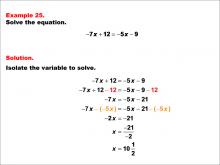
|
Math Example--Solving Equations--One-Variable Equations: Example 25 | One-Variable Equations: Example 25TopicEquations DescriptionThis example involves solving a one-variable equation that may include complex terms or require multiple steps to simplify. The equation might involve fractions, decimals, or variables on both sides. Solving it involves using inverse operations, distributing terms, and combining like terms to isolate the variable. This type of problem helps students refine their algebraic skills and understand the importance of systematic problem-solving. Checking the solution by substituting it back into the original equation is a crucial step to ensure accuracy. |
Solving Multistep Equations, Solving One-Step Equations and Solving Two-Step Equations |
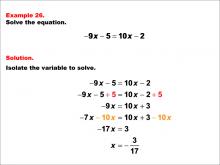
|
Math Example--Solving Equations--One-Variable Equations: Example 26 | One-Variable Equations: Example 26TopicEquations |
Solving Multistep Equations, Solving One-Step Equations and Solving Two-Step Equations |
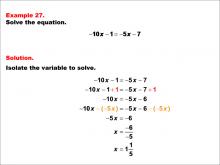
|
Math Example--Solving Equations--One-Variable Equations: Example 27 | One-Variable Equations: Example 27TopicEquations |
Solving Multistep Equations, Solving One-Step Equations and Solving Two-Step Equations |
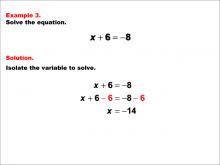
|
Math Example--Solving Equations--One-Variable Equations: Example 3 | One-Variable Equations: Example 3TopicEquations |
Solving Multistep Equations, Solving One-Step Equations and Solving Two-Step Equations |
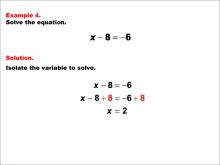
|
Math Example--Solving Equations--One-Variable Equations: Example 4 | One-Variable Equations: Example 4TopicEquations DescriptionThis example likely demonstrates solving a more complex one-variable equation. It may involve multiple steps, such as combining like terms, using the distributive property, or dealing with fractions or decimals. The solving process typically includes isolating the variable on one side of the equation by performing inverse operations on both sides. This type of problem enhances students' algebraic manipulation skills and prepares them for more advanced equation solving. The specific solution would involve carefully following the order of operations and checking the final answer by substituting it back into the original equation. |
Solving Multistep Equations, Solving One-Step Equations and Solving Two-Step Equations |
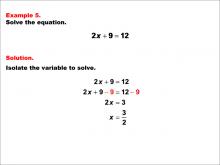
|
Math Example--Solving Equations--One-Variable Equations: Example 5 | One-Variable Equations: Example 5TopicEquations DescriptionThis example likely showcases a more challenging one-variable equation. It may involve variables on both sides of the equation, requiring students to consolidate like terms before solving. The problem might also include parentheses, necessitating the use of the distributive property. Solving this equation would involve carefully balancing operations on both sides, possibly dealing with negative numbers or fractions. This type of problem helps students develop their algebraic reasoning skills and reinforces the importance of maintaining equation balance throughout the solving process. |
Solving Multistep Equations, Solving One-Step Equations and Solving Two-Step Equations |
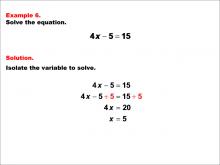
|
Math Example--Solving Equations--One-Variable Equations: Example 6 | One-Variable Equations: Example 6TopicEquations |
Solving Multistep Equations, Solving One-Step Equations and Solving Two-Step Equations |
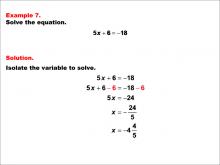
|
Math Example--Solving Equations--One-Variable Equations: Example 7 | One-Variable Equations: Example 7TopicEquations DescriptionThis example presents a one-variable equation that may involve variables on both sides. The solving process requires moving all terms involving the variable to one side and constants to the other. This often involves using the distributive property and combining like terms. The goal is to isolate the variable and solve for its value. This type of problem helps students develop their algebraic manipulation skills and understand the importance of maintaining balance in an equation. Checking the solution by substituting it back into the original equation is crucial to ensure accuracy. |
Solving Multistep Equations, Solving One-Step Equations and Solving Two-Step Equations |
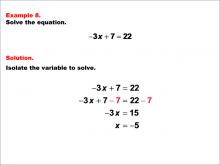
|
Math Example--Solving Equations--One-Variable Equations: Example 8 | One-Variable Equations: Example 8TopicEquations DescriptionThis example involves solving a one-variable equation that might include complex expressions, such as those with parentheses or multiple terms. The solving process may require using the distributive property to eliminate parentheses and combining like terms to simplify the equation. After simplification, standard techniques are used to isolate the variable. This example reinforces the importance of following the order of operations and checking the solution for accuracy. Mastery of these skills is essential for tackling more advanced algebraic problems. |
Solving Multistep Equations, Solving One-Step Equations and Solving Two-Step Equations |
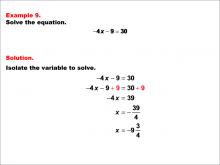
|
Math Example--Solving Equations--One-Variable Equations: Example 9 | One-Variable Equations: Example 9TopicEquations DescriptionThis example deals with solving a one-variable equation that may involve more complex algebraic expressions, such as nested parentheses or fractional coefficients. The solving process requires careful application of the distributive property and combining like terms. After simplifying the equation, inverse operations are used to isolate the variable. This example highlights the importance of precision in algebraic manipulation and the necessity of verifying solutions by substituting them back into the original equation to ensure correctness. |
Solving Multistep Equations, Solving One-Step Equations and Solving Two-Step Equations |
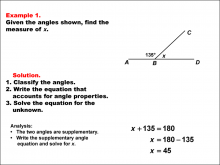
|
Math Example--Solving Equations--Solving Equations Using Angle Properties: Example 1 | Solving Equations Using Angle Properties: Example 1TopicEquations DescriptionThis example demonstrates solving equations using angle properties, specifically focusing on supplementary angles. Supplementary angles are two angles that add up to 180 degrees. In this case, we have one known angle of 135° and an unknown angle x. To solve such equations, we use the fundamental property of supplementary angles: their sum equals 180°. |
Applications of Equations and Inequalities and Definition of an Angle |
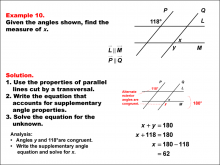
|
Math Example--Solving Equations--Solving Equations Using Angle Properties: Example 10 | Solving Equations Using Angle Properties: Example 10TopicEquations DescriptionThis example illustrates solving equations using angle properties, focusing on parallel lines cut by a transversal and supplementary angles. When parallel lines are cut by a transversal, pairs of supplementary angles are formed, meaning they sum to 180°. In this scenario, we have one known angle of 118° and an unknown angle x. However, angle y and the 118° angle are alternate exterior angles, which are congruent. This means we can set up this equation using the property of supplementary angles: 118 + x = 180 |
Applications of Equations and Inequalities and Definition of an Angle |

|
Math Example--Solving Equations--Solving Equations Using Angle Properties: Example 2 | Solving Equations Using Angle Properties: Example 2TopicEquations DescriptionThis example illustrates solving equations using angle properties, focusing on supplementary angles. Supplementary angles are two angles that sum to 180 degrees. In this scenario, we have one known angle of 75° and an unknown angle x. The equation for supplementary angles is always in the form: angle1 + angle2 = 180°. Here, we can write 75 + x = 180. To solve for x, we subtract 75 from both sides: x = 180 - 75, giving us x = 105°. |
Applications of Equations and Inequalities and Definition of an Angle |

|
Math Example--Solving Equations--Solving Equations Using Angle Properties: Example 3 | Solving Equations Using Angle Properties: Example 3TopicEquations DescriptionThis example demonstrates solving equations using angle properties, specifically focusing on straight angles and vertical angles. A straight angle measures 180°, and vertical angles are always congruent. In this scenario, we have two known angles (36° and 72°) and an unknown angle x. This unknown angle x is vertical (and therefore congruent) to angle z. The angles 36, 72, and z form a straight, but since z is congruent to x, we can write the sum of this straight angle: x + 36 + 72 = 180 x = 72° |
Applications of Equations and Inequalities and Definition of an Angle |
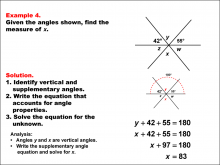
|
Math Example--Solving Equations--Solving Equations Using Angle Properties: Example 4 | Solving Equations Using Angle Properties: Example 4TopicEquations DescriptionThis example illustrates solving equations using angle properties, focusing on straight angles and vertical angles. A straight angle measures 180°, and vertical angles are always congruent. In this scenario, we have two known angles (42° and 55°) and an unknown angle x. However, angle x is vertical (and therefore congruent) to angle y. The equation can be set up based on the fact that the sum of angles on a straight line is 180°. Thus, we have: 42 + 55 + x = 180 |
Applications of Equations and Inequalities and Definition of an Angle |
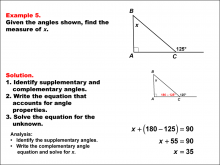
|
Math Example--Solving Equations--Solving Equations Using Angle Properties: Example 5 | Solving Equations Using Angle Properties: Example 5TopicEquations DescriptionThis example demonstrates solving equations using angle properties, specifically focusing on complementary angles and the exterior angle theorem. Complementary angles are two angles that sum to 90°, while the exterior angle theorem states that an exterior angle of a triangle is equal to the sum of the two non-adjacent interior angles. In this scenario, we have a right angle (90°), an exterior angle (125°), and an unknown angle x. Using the exterior angle theorem, we can set up the equation: x + 90 = 125. To solve for x, we subtract 90 from both sides: x = 35°. |
Applications of Equations and Inequalities and Definition of an Angle |
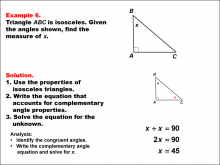
|
Math Example--Solving Equations--Solving Equations Using Angle Properties: Example 6 | Solving Equations Using Angle Properties: Example 6TopicEquations DescriptionThis example illustrates solving equations using angle properties, focusing on an isosceles right triangle. An isosceles right triangle has a right angle (90°) and two equal angles. In this scenario, we have the right angle given, and the two unknown equal angles represented by x. The equation can be set up based on the fact that the sum of angles in a triangle is 180°. Thus, we have: 90 + x + x = 180, or simplified, 90 + 2x = 180 To solve for x, we first subtract 90 from both sides: 2x = 90. Then, dividing both sides by 2, we get: x = 45°. |
Applications of Equations and Inequalities and Definition of an Angle |
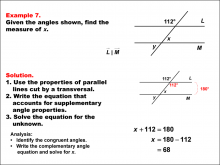
|
Math Example--Solving Equations--Solving Equations Using Angle Properties: Example 7 | Solving Equations Using Angle Properties: Example 7TopicEquations DescriptionThis example demonstrates solving equations using angle properties, specifically focusing on parallel lines cut by a transversal and same side interior angles. When parallel lines are cut by a transversal, same side interior angles are supplementary, meaning they sum to 180°. In this scenario, we have one known angle of 112° and an unknown angle x. The 112° angle is vertical to the same side interior angle paired with x. The equation can be set up as: 112 + x = 180 |
Applications of Equations and Inequalities and Definition of an Angle |

|
Math Example--Solving Equations--Solving Equations Using Angle Properties: Example 8 | Solving Equations Using Angle Properties: Example 8TopicEquations DescriptionThis example illustrates solving equations using angle properties, focusing on parallel lines cut by a transversal and alternate interior angles. When parallel lines are cut by a transversal, alternate interior angles are congruent, meaning they have the same measure. In this scenario, we have one known angle of 48° and an unknown angle x. Since x and y are alternate interior angles, they are congruent. We can now use the property of supplementary angles to solve for x: x + 48 = 180 x = 132° |
Applications of Equations and Inequalities and Definition of an Angle |

|
Math Example--Solving Equations--Solving Equations Using Angle Properties: Example 9 | Solving Equations Using Angle Properties: Example 9TopicEquations DescriptionThis example demonstrates solving equations using angle properties, specifically focusing on parallel lines cut by a transversal and alternate interior angles. When parallel lines are cut by a transversal, alternate interior angles are congruent, meaning they have the same measure. In this scenario, we have one known angle of 43° and an unknown angle x. However, angle x and angle y are alternate interior angles and are congruent. This means that x and teh 43° angle are same side interior angles, which are supplementary. We set up this equation: |
Definition of an Angle and Applications of Equations and Inequalities |
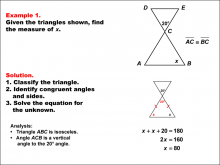
|
Math Example--Solving Equations--Solving Equations Using Triangle Properties: Example 1 | Solving Equations Using Triangle Properties: Example 1TopicEquations DescriptionThis example focuses on solving equations using the properties of similar isosceles triangles. Isosceles triangles are characterized by having two equal sides and two equal base angles. In this case, we have two similar isosceles triangles, which means they share the same shape but may differ in size. The equation to be solved involves finding the unknown angle x, given that one of the angles is 20°. The property of vertical angles tells us that the angle vertical to the 20° angle is also 20° |
Applications of Equations and Inequalities and Applications of Triangles |
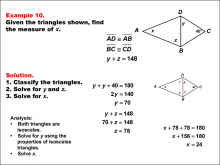
|
Math Example--Solving Equations--Solving Equations Using Triangle Properties: Example 10 | Solving Equations Using Triangle Properties: Example 10TopicEquations DescriptionThis example, similar to Example 9, involves solving equations using the properties of a kite and applying the exterior angle theorem. We are again given one angle of 40° and two unknown angles, y and x. The goal is to set up and solve equations to find the values of y and x using the properties of kites and the exterior angle theorem. Key properties to consider: |
Applications of Equations and Inequalities and Applications of Triangles |
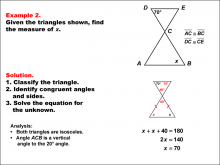
|
Math Example--Solving Equations--Solving Equations Using Triangle Properties: Example 2 | Solving Equations Using Triangle Properties: Example 2TopicEquations DescriptionThis example explores solving equations using the properties of similar isosceles triangles, building upon the concepts introduced in Example 1. In this case, we have two similar isosceles triangles with one known angle of 70° and an unknown angle x. The goal is to determine the value of x using triangle properties and algebraic techniques. |
Applications of Equations and Inequalities and Applications of Triangles |
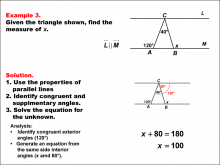
|
Math Example--Solving Equations--Solving Equations Using Triangle Properties: Example 3 | Solving Equations Using Triangle Properties: Example 3TopicEquations DescriptionThis example focuses on solving equations involving parallel lines cut by a transversal, a fundamental concept in geometry. The problem presents two parallel lines intersected by two transversals that also form a triangle. We are given that one angle measures 120° and the corresponding angle can be expressed as (y + 40)°. The goal is to determine the value of y using the properties of angles formed by parallel lines and a transversal. When parallel lines are cut by a transversal, several important angle relationships are formed: |
Applications of Equations and Inequalities and Applications of Triangles |